
I've been kind of excited and been wanting to do this series for quite a while after I finished with Pokemon. You see, reviewing every single Pokemon had ended up gotten me to think about why I enjoyed myself doing so, and I think it's because I just enjoy talking about fantasy monsters in general. I'm planning to do a once-a-month (or thereabouts) project of reviewing, or, well, commentating on video game monsters!
So today we'll be taking a look at one of the pioneers of RPG video games, which is The Legend of Zelda. The original one, which lacks any of the real story elements that made games like Breath of the Wild, Ocarina of Time, Majora's Mask, A Link to the Past and all the other far better-known entries in the franchise so much more memorable. The original Legend of Zelda game is honestly kind of a game that's... just a huge sandbox with no depth to it, and while it certainly has an important role in being the grandfather to one of my all-time favourite video game franchises of all time, it's a huge mess of a game.
What it did manage to do, though, is to codify a bunch of monsters, altered from classic fantasy tropes (and D&D, and Tolkien stuff) in order to make a bunch of enemies that are pretty original to the franchise. While these appearances would eventually be overtaken by far more memorable designs released in better games, I'm going back and reviewing these pixelated enemies first seen in the very first Legend of Zelda, released all the way back in 1986.
This is going to be an on-and-off series. I'll be jumping around video games and reviewing the monsters seen in those games as I see fit, similar to what I do with Pokemon. And 'review' is, I guess, a pretty loose term and a bit of a misnomer. Commentary, I guess? I'll try and make this a monthly series, but expect fluctuations on the schedule depending on my mood. Anyway... Zelda time! Thanks to the various Zelda wikis for providing the images and sprites, too.
________________________
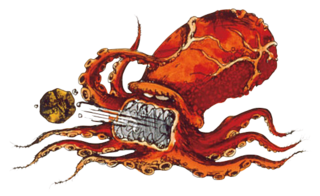
Octorok:
The humble Octorok is one of the very first enemies that Link will meet in his journey, and has grown to be one of the most staple enemies found in the series. Octoroks are these octopus that, for whatever reason, crawl on land, and shoot out rocks from their sucker-mouths. While these sucker-mouths are in real life function more as a propulsion vent more than a mouth (an octopus's real mouth is a hard beak) it's the way that octopi tend to be portrayed in Japan. Octoroks act as a relatively simple enemy for Link to beat up, but I do like the concept of Nintendo just smooshing two seemingly unrelated things together, and while the depiction of Octoroks would change over the years (particularly revamped into actual water-dwelling cephalopods in most of the 3D games), the core of the concept is pretty much the same and I do appreciate this wacky, if simple, monster.
Tektite:
Anyone who reads my Pokemon design reviews will know that I really, really really love insects, and just like most fantasy settings, the Legend of Zelda features bugs as one of their weaker monsters. While the Tektites in some 3D games borrow a lot from water striders, the most common portrayal of Tektites basically don't deviate too much from what they look like in the original game. A sphere with a singular, decidedly non-buggy eye, with four segmented legs, and they move around by jumping around in ways that Link tend to not be able to replicate. Huge, prominent eyeballs have always been a welcome design feature in monsters, and spindly buggy legs are also very welcome. I think I ultimately prefer the more insectoid Tektites seen in Ocarina of Time or Twilight Princess, but the pretty simple concept of a jumping bug with a huge eyeball is pretty charming. Not all the enemies got actual artwork in the original Legend of Zelda, and the Tektites are one of those without.

Leever:
Leevers are kind of these ambiguous burrowing, spinning lumps of... of things that just spin around with spikes or tentacles on its side. Leevers are found mostly in sandy areas, popping in and out of the sand as they chase after Link, and if not for their name (which is only mentioned in the manual for the original Legend of Zelda), it's honestly pretty ambiguous what this sort of monster is supposed to be. And even then, it's pretty interesting that they decided to have one of their few plant monsters be, well, this fleshy burrowing blob. Hell, they behave more like the extensions of giant enemy worms or something! Later games would make the plant aspect somewhat more clear, but while they don't rank highly among my personal favourites, I do enjoy Leevers as part of the mythos of Hyrule as these weird-ass ambulatory plants.

Peahat:
The Leever's cousin, Peahats are plants that just helicopter around the place, sort of a fun combination of a flying spore and an actual bulbous self-sustaining plant. Airborne plants are one of those things that don't exist in real life, and you'd think they would make for a much more common monster trope in fantasy settings, but I honestly struggle to think of flying plants from D&D or Warcraft or whatever. I'm not sure what "Peahat" is supposed to be a pun of, but I do enjoy this bizarre flying helicopter plant that will cut you the fuck up. Original Legend of Zelda Peahat is pretty boring, but maybe that's just because I am way too used to its 3D-game counterparts.

Keese:
Found almost exclusively in dungeons, Keese (a pun on 'kiss', I think) are... they're basically just bats, yeah? They're small, weak, flighty, and tend to hide in walls and camouflage themselves until Link walks past them. Subsequent games would play around just what a Keese is, ranging from an eyeball with wings to giant fanged bats to sickle-tailed bat monsters, but it's clear that they're just, well, bats. It's nothing special, I guess, but the Keese has been a fixture of literally every Zelda game since its inception. I guess there's just something about hostile bats in caves that just appeal to the fantasy genre, huh? I mean, Goddamned Bats is an actual video game trope.

Vire
The sprite for Vire here is like this fat, bat-winged demons with four eyes that straight-up just bounce around. They actually in the more difficult dungeons in the game, and basically fill a role similar to demons or gargoyles. Interestingly, though, the Vire will split into two Keeses upon seemingly being defeated, which is just kinda weird. The Vire is... it's kind of unmemorable, honestly, not showing up a whole lot in Legend of Zelda and very rarely being revisited in subsequent games. I don't mind it, but for a fat, pudgy bat demon, the Vire really doesn't bring much to the table, does it?

Like Like
Oh, the Like Like. This gross, throbbing, pulsating... thing. I've seen the Like Like show up in way more games than I've cared to count, and it's always this weird, three-segmented cylindrical barrel-like creatures that move slowly around the stage. Its name, Like Like, doesn't really give any indication as to what it's supposed to be, and both its official artwork and all subsequent incarnations are all blissfully vague. Is the Like Like a plant monster? A slime monster? A worm? It's just such a bizarre design, and its special ability -- which is to basically eat Link and briefly 'digest' him before spitting him out -- is pretty damn gross and disturbing to watch, especially in games where it's actually animated. The Like Like also tends to eat Link's items, namely his shield in this very first appearance, basically reducing Link's magical shield back to its shittiest form. Link has to kill the Like Like quickly after being spat out for any hope of recovering his shield. They are way more obnoxious in subsequent games, and I honestly do like just how ambiguous the Like Like is. It's a creature that feels original to the setting of Hyrule instead of being "just another bug/plant/rock monster" (although those certainly have their charms), and its large amount of recurrence in the series has really cemented the Like Like as an incomprehensible, familiar and irritating enemy.

Rope:
On the other spectrum of design creativity is Rope. Otherwise known as "just a snake". All fantasy settings tend to have a couple of animals that remain relatively unchanged from their real-world counterparts, except in size and behaviour. And Ropes are just, well, cartoon snakes. I really don't have all that much to say here, honestly. They show up mostly in dungeons, and have a fun little behavioural gimmick where they move very slowly, but suddenly charge really quickly when they see Link. It's neat to have some enemies in RPG settings that are just familiar animals (because if everything is a special monster, nothing is), but I'll always not find a lot to talk about them.
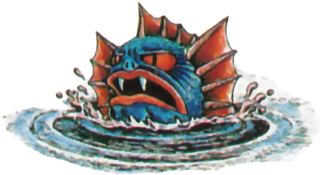
Zora:
Originally transcribed as "Zola" in English translations, the Zora are basically just these ugly-looking rotund fish-men that pop out of rivers and shoot fireballs (for some reason) at Link, and it's near impossible for Link to fight back due to him unable to reach the water. It's not the most impressive-looking enemy and honestly kind of boring since all you ever see is just their head. Later games would revamp the Zora into a completely different species of sentient merpeople that act as the 'elves' of Hyrule's setting, but in a lot of these pre-Ocarina-of-Time games, Zoras basically are these mean, grumpy-looking fat fish-men that's a wee bit more similar to the Sahuagin of D&D. While they aren't particularly memorable in their first appearance, I do appreciate them trying to make Hyrule feel a bit more diverse by having aquatic monsters. Diversity is an important part in worldbuilding!


Gel & Zol:
You gotta have your slime monsters in a fantasy setting, and in the original Legend of Zelda, it's the Gel. Which are... just little teardrop-shaped blobs that don't do much but bounce around and will only hurt Link when it touches him. Pretty boring enemy, honestly, clearly meant to be a weakling...
Until you encounter the Gel's bigger cousins, the Zols, which are cute little beanbag shaped slime-blobs with eyes. They're slightly tougher than Gels, but when you kill a Zol, it splits into two Gels! Ultimately, it's a very simple gimmick, just a slightly-stronger enemy that splits into two weaker enemies, but it does sell the fantasy of a slime monster pretty well with a simple ability. For a pretty simple game like the original Legend of Zelda, it's pretty neat. And, y'know, slime monsters are pretty important to have! How else would you know that all the other dragons and dinosaurs and demon gods are special if you don't have a humble blob monster to compare them to?

Moblin:
Every fantasy setting needs their dumb, orc/ogre/goblin counterpart (even in settings where orcs and goblins are sentient, other creatures take their place), and for Legend of Zelda, it's the Moblins and their relatives. The original Legend of Zelda basically casted them as these orc-like
Goriya:
These dudes aren't gorillas like their name would suggest, but seem to be beast-people with some really fancy beards. And unlike the spear-wielding Moblins, Goriyas use ranged weapons, namely boomerangs, to try and hit Link. The official artwork for the Goriya show them as some sort of... badger-people? Wolf-people? And apparently that huge white mustache thing is meant to be the underside of the Goriya's animal snout? I never really realized that, because in all of the Goriya's subsequent appearances, they have been portrayed in various different ways from almost-mechanical golem-like beings to bulldog people to funny fat people with giant white mustaches. I do love those mustaches. Are they supposed to represent the Goriya's boomerang weapon? I dunno. I just keep looking at that official artwork and scratching my head because that is definitely not how I picture a Goriya in my head.

Armos:
The Armos are these mysterious orange... statues? Reanimated golems? Sentient suits of armour? They have a single eye and hold a giant fork and a shield, and dot the overworld of Hyrule. Actual living Armoses and statues that look like Armoses are all over Hyrule, and they are all immobile until Link makes contact with them, upon which they will scuttle towards Link pretty quickly. They're vulnerable to bombs, I think? It's a fun adaptation of the living statue monster trope, although the original Armos from Legend of Zelda was honestly pretty forgettable -- even moreso than the Moblins, I think the Armoses are done far better in subsequent titles.

Lynel:
Lynels are these centaur-like monsters that's relatively unique to Legend of Zelda, except instead of being half-horse, they are half-lion. It's an interesting way to make a fantasy creature -- centaurs tended to be equine, while cat-people tended to be bipedal in most fiction, so combining the two certainly results in a pretty fun and unique creature... even if that official artwork seems to have given the Lynel skinny horse legs anyway. Lynels are neat but definitely underwhelming in the original Legend of Zelda -- it's not until A Link to the Past where they end up being one of the strongest enemies in the game, and not until the most recent game, Breath of the Wild, where they are straight up horrifying minibosses. And look damn badass too. I do like that the sprites used for the Lynels, thanks to the limitation of the engine, seem to just have blades jutting out of their elbows.

Stalfos:
Stal-whatever is a term that will become synonymous with "skeleton monster" in this series. And you got to have undead in some capacity in any fantasy setting. Zelda tend to stick with just ghosts and skeletons, which is fine -- those are the most important undead monsters anyway. Oh, and mummies, which we'll cover later. The Stalfos is just a skeleton dude with two swords. Later entries in the franchise would actually make Stalfoses a lot more dangerous than simple 'stab them in the face' monsters, but in original Legend of Zelda, they are just kind of fodder.

Gibdo:
I'm not sure what "Gibdo" is supposed to be a pun of. It's basically just a mummy enemy, though, and basically uses the exact same animation as the Stalfos, and isn't particularly much more powerful. They're... they're just mummies, is all. As someone who played through a lot of the newer Zelda games before playing the original Legend of Zelda, it's honestly kind of surprising. Not much to say here -- when I get to the Gibdos in the newer games, I'll have a lot more to say.
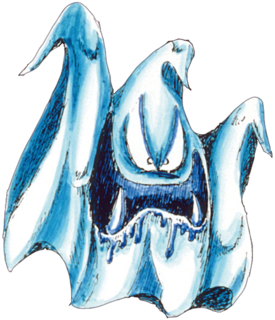
Ghini
A corruption of the Japanese pronunciation of "genie", Ghinis only appear on the graveyards in Hyrule, and only appear if Link touches a gravestone, which is a neat little gimmick showing an angry ghost attacking Link. Ghinis are actually one of the strongest non-boss enemies in the game, taking a ridiculous amount of force to defeat, although since they are kind of an optional encounter that only happens if Link fails to solve a puzzle, I guess it's okay? They also operate on a weird little 'shared health pool' thing, so when Link defeats a single Ghini, all the other Ghinis in the room just die. Worth noting that the Ghini perhaps has the most different looking official artwork compared to its sprite -- all of the Ghini's subsequent appearances will homage the one-eyed blob-ghost sprite and ignore that sheet ghost with orc fangs.
Darknut:
Known in Japan as "Tato Nakku", short for the English words "Tart Knuckle", these guys are known as Darknuts in English releases and... wow, they are pretty boring, huh? They're (ambiguously human) dudes in traditional medieval fantasy armour with a shield and a sword, and even that artwork looks pretty boring. I have been so used to Darknuts being pretty badass black knights that serve as minibosses and really tough enemies in dungeons thanks to Twilight Princes and Wind Waker that I completely forgot that they started off as honestly pretty bland enemies. At least the Darknut in the original Legend of Zelda are kind of tough to take down, showing up in the later dungeons, and thanks to their shield they are completely immune to all attacks from the front. They still basically try to overwhelm you with numbers more than anything, though.

Bubble:
The actual sprite doesn't make it really clear, but Bubbles are these flying floating skulls wreathed in fire. Unlike all of the Bubble's subsequent appearances, the Bubble in Legend of Zelda don't actually damage Link, but 'curses' him and disables his sword for a couple of seconds. They're more of an annoyance than an actual enemy, but showing up alongside huge swarms of Darknuts or whatever is definitely going to give you a bad day. A definitely interesting enemy, and it's honestly kind of a shame that Bubbbles have lost this particular characteristic of theirs with modern games casting them as yet-another-monster.

Wallmaster:
One of the most iconic monsters in Legend of Zelda is the Wallmaster. The Wallmasters are blue, floating disembodied hands that appear out of walls and try to chase down Link, and when they grab Link? They just straight up teleport Link back to the beginning of the dungeon, forcing you to basically run all the way back to where you left off. Like the Bubble, it's a unique way of inconveniencing the player and another way to bar Link's journey through Hyrule beyond just killing him. And the simple concept of this eerie, giant demonic hand popping out of nowhere to just deposit you out of the dungeon is definitely far creepier than mere skeletons or mummies -- those, at least, you can kill. The Wallmaster is just untouchable, unexplained, and especially in future incarnations, some of the most atmospheric and terrifying enemies in the franchise.
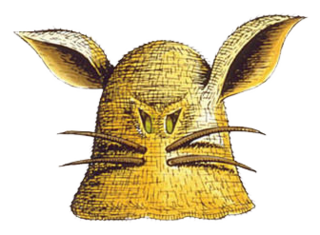
Pols Voice
What a bizarre fucker, huh? Pols Voice (Pol's Voice? Pols' Voice? Who is Pol?) are these disembodied rabbit heads that bounce around the room and take a huge amount of punishment. They're also apparently ghosts of some sort? The official artwork throws in some bizarre ambiguity, because apparently those aren't cute bunny ears, but some huge nostrils above the Pols Voice's whiskers! In the game, they are very weak to arrows.... but their name and the instruction manual notes how Pols Voice "hates loud noises". This is a reference to the original Japanese hardware that has a microphone, and you shouting into the microphone will kill the Pols Voices... but the microphone was not incorporated into the NES sold worldwide, causing their weaknesses to be changed to arrows. But the manual, the in-game hints and their names are still note how these things hate loud noises... which is complicated by the game actually having a Recorder item which does nothing to the Pols Voice. Regardless, even without this clusterfuck of translation goofs, Pols Voice still remain pretty bizarre. Whether they are ghosts or weird bunny creatures, they manage to look both cute and unsettling.
Wizzrobe:
Enemy sorcerers! The Wizzrobes are one of the more difficult enemies that Link will face, mostly because they are immune to everything but the sword, and show up as the tough enemies in the later dungeons in Legends of Zelda. They shoot magical bolts from a distance and teleport around the room, while at the same time defying wizard stereotypes by not actually being squishy. Absolutely love their classic design of being just a fully-robed dude with two glowing eyes inside a dark hood, which is always a welcome visual. It's one of the most iconic designs from Legend of Zelda, one that's simple yet pretty effective, communicating that these Wizzrobes are, well, evil wizard enemies. Pretty cool dudes, honestly, and they are also some of the more common recurring enemies in the series as a whole.
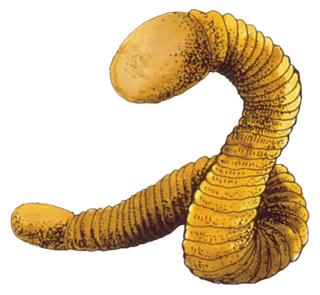
Moldorm:
Often depicted in future material as googly-eyed centipede monsters or other sort of segmented invertebrate, the original Moldorm was apparently meant to be just a big giant earthworm! The sprite is just a bunch of spheres linked together, though. The Moldorm acts as kind of the miniboss of some early dungeons before becoming a bit more common, and when Link hacks off the Moldorm's segments, sometimes it just splits into two smaller Moldorms -- presumably a reference to the earthworm's exaggerated ability to continue living as two worms when you cut it in two (which is wrong, by the way, don't go around cutting earthworms) The Moldorm will get revamped into a semi-consistent recurring weak miniboss in most of the 2D games. It's definitely an interesting giant worm monster, for sure.
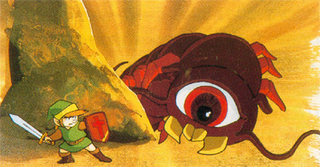
Lanmola:
A stronger miniboss than the Moldorm, the Lanmola is only found in the ninth dungeon, and while in-game looks basically like a Moldorm with an extra head, the official artwork makes it a one-eyed weird centipede monster. Like the Moldorm, the Lanmola needs to be hit until all of its segments are destroyed, but the Lanmola moves rapidly and quickly, while only its rear end is vulnerable. This behaviour will actually be assigned to Moldorms in later games, while future Lanmolas tend to have "burrow into the ground" mechanics. Kind of a simple enemy, but I do like it.

Patra:
The Patra is one of the few enemies that has never made an appearance outside of this very first installment of the franchise. Every other enemy on this page has reappeared in some way or form in subsequent installments of Legend of Zelda except for poor Patra here. Patras show up only in the ninth dungeon as a miniboss, being a swarm of eyeballs with wings -- a central purple one that's bigger, with a bunch of small orange ones circling it. It's basically a simple "beat the smaller Patra units before the central one becomes vulnerable", although the trick is that there are actually two kinds of Patras -- one has its little units contract and retract, while another has the little units spin around it quickly. It's an interesting extra enemy that only shows up in this final dungeon, and really helps to make the otherwise-similar-to-all-the-other-dungeons final dungeon feel a lot more like it's the final dungeon with unique enemies. These days, Patra's gimmick of having smaller versions of itself cover it has been taken over by the far more distinctive and badass looking eyeball-jellyfish monster Arrghus.
_________________
BOSSES:
Of course, no Legend of Zelda game is a Legend of Zelda game without bosses waiting for you at the end of the dungeons. The original Legend of Zelda didn't really have a lot of thematic dungeons -- none of the lava level, aquatic level, dark level stuff that made so many of the subsequent games so memorable, so the only real thing that distinguishes the original dungeons of Hyrule are the bosses. Here we go, in order of the way they're fought: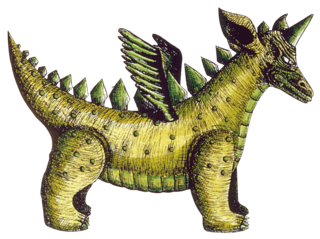
Aquamentus:
The boss of the first dungeon is Aquamentus, which is... a funny and awkwardly-drawn dragon seen from the profile. It's basically the most awkward-looking dragon ever, with a bucktooth, chunky legs, weird leery eyes and a body shape that's more like a deformed cheap plastic toy than an actual dragon. Hell, look at that official artwork! It's clear they didn't really even try, and wanted Aquamentus to just look awkward to contrast the more badass dragon boss they have later on. Aquamentus basically just shoots fireballs at Link, but a couple of whacks to his head will kill him. Hilariously, Aquamentus returns for the seventh dungeon as its boss... but is just as weak as he was before. Poor Aquamentus. No wonder no one really remembers you super fondly.

Dodongo:
Another one of those recurring enemies in the franchise, the Dodongo is the boss of the second dungeon, and he's basically just a giant, angry Ceratopsian dinosaur. Future incarnations of the Dodongo will alternate wildly in portrayal, going from ceratopsian monsters to two-legged kaiju dinosaurs to fire-breathing geckos. The Dodongo's weakness is noted by the old man as "Dodongo dislikes smoke" [sic], which is a clue to its weakness, which is dropping bombs in front of the Dodongo and have it swallow the bomb, have it explode inside of it and causing it to become vulnerable. In fact, this vulnerability to bombs is something that is basically universal for all other Dodongos in the franchise. Initially the boss of the second dungeon, multiple Dodongos would serve as minibosses in some of the later dungeons. Not super original, but not bad for one of the lesser bosses.

Manhandla
A different sort of killer plant than Mario's Piranha Plants, the Manhandla is a weird little sphere with four Pac-Man-esque venus flytrap maws on all four sides of its body. And honestly, I definitely didn't realize that Manhandla was supposed to be a plant monster when I first saw that sprite, thinking that it's just an ambiguous multi-beaked monster. Subsequent appearances are a lot more explicit. Manhandla shoots fireballs from its Pacman mouths at Link while it moves around, and Link has to destroy the heads individually with swords or bombs... but Manhandla goes crazy and moves faster the more heads Link destroys. It's an interesting plant monster, if one that ends up ultimately looking like weird eyeless multi-headed turtle barnacle thing instead of a plant. Like the Dodongo, the Manhandla will reappear in various dungeons after he's defeated as minibosses.
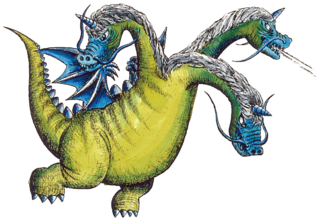
Gleeok
And this is why Aquamentus looks dumb -- the boss of the fourth dungeon, Gleeok, is a far more badass two-headed dragon/hydra beast that you see from above instead of from profile. Gleeok is immobile and launches fireballs from its two undulating heads... but once Link deals enough damage to one of the Gleook heads, the head will detach, burst in flames and fly around independently. A three-headed Gleeok acts as a mini-boss, and a mighty four-headed Gleeok shows up as the boss of the penultimate dungeon. Overall, it's a simple monster fantasy -- a multi-headed draconic beast has always been common, whether it be hydra or Typhon or orochi. It's a neat way to have a recurring boss enemy that's familiar but becomes significantly more difficult because, y'know, extra heads.

Digdogger
Kickstarting a proud tradition of giant eyeball boss enemies is the fifth boss, Digdogger, which is a giant orange sphere with an eyeball in the center, and spikes around it. Digdogger's official artwork makes it look even weirder, making Digdogger's main body look like some sort of bizarre limpet barnacle, with tentacles protruding around it. Digdogger is all but invincible if you don't know its weakness. With the clue of "Digdogger hates certain kind of sound" [again, sic] that you may find while wandering the overworld, Link has to use the whistle item found in the dungeon which will somehow cause this eyeball monster that has no ears of any sort to shrink down into just his eyeball, leaving him vulnerable to a single strike. After his role as a boss, Digdogger will reappear in the final dungeon as minibosses, with the added difficulty of splitting into three smaller mini-Digdoggers.
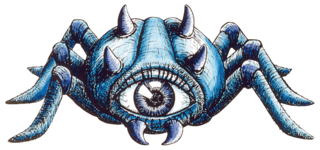
Gohma:
Another recurring boss in the franchise, the original Gohma is just this crab/spider-like monster whose main body is dominated with a single eye. Gohma just crawls side to side and shoots fireballs at Link that he can't block. Link has to wait until Gohma fully opens her eye and shoots arrows into that eye... and the Gohma straight-up just dies in one shot. It's kind of silly, honestly. The original Gohma is honestly kind of disappointing, not looking that much different than the standard Tektite enemy. Subsequent entries will try their best to make everyone's favourite one-eyed crabspider monster look so much more threatening and badass.

Ganon
The first ever appearance of Ganon is, well, just a big fat pig-man. The manual tells us that this Prince of Darkness, Ganon, kidnapped princess Zelda and unleashed all the monsters into Hyrule. And... that's about it. Evil overlord, kill him! It's not until A Link to the Past and Ocarina of Time that Ganon is a bit more defined as a character -- and while Ganon isn't the most intricate character out there, at least it's better than random pig-man overlord. The fight against Ganon is pretty much the only time in this entire game where wacky tactics are employed, though. Ganon goes invisible when the fight begins, and shoots unblockable fireballs. You have to watch the pattern and figure out where Ganon will be, and after playing cat-and-mouse with the invisible Ganon, Link has to shoot him with the Silver Arrow... an item that you may or may not have obtained (Legend of Zelda is revolutionary, but it has some shitty game design choices) to ultimately vanquish Ganon once and for all.
Overall, it is... it's definitely fun to look back at what these enemies look like, and how some of them are envisioned in the past. A lot of these enemies' appearances owe to the franchise's soft reboot in A Link to the Past and Ocarina of Time, both genre-defining games that really tried to tell a story with the game instead of just throwing you into a barren wasteland. Some of these monsters remain relatively unchanged other than better graphics, while some end up being heavily revamped upon translation to newer games. It's also genuinely interesting to see how early some of these monsters had shown up, and how some, like Gohma or the Octoroks or the Wizzrobes -- recur so many times across the franchise, while some, like Patra, Vire or Aquamentus, are just kind of forgotten.
It's been fun! I'll definitely do this sort of monster review/recap/commentary for some of the more influential Legend of Zelda games. Ocarina of Time, A Link to the Past, Breath of the Wild and Twilight Princess for sure. For the rest... we'll see. Next week, we'll start off on Digimon, but intermittently I'll cut over to other franchises and video games.
Weird factoid on the armos is the manual says they're "a soldier who has been turned into a stone statue", unlike every other game which show them as always granite. Maybe its a mistranslation.
ReplyDeleteZoras are referred to as female here, but I read the Japanese text was gender neutral.
Goriyas really do have a mustache, if you look closely at the artwork, you can tell, hence why their neck is blue and not white like their mustache. This can be seen in later games as well as the satellaview remake of the first game.
It probably could be just a mistranslation, older games tend to have less quality control among these sort of things -- both things like the Zora's gender and the Armos being originally human. It's probably things like sentence syntaxes that caught the translators off-guard.
DeleteI like the Goriyas better as mustache animal men for sure! Mustaches are funny!
Both made it under the CD-I games, interestingly.
DeleteI like the mustaches too.
That reminds Aquamentus is described as part Unicorn and the animated series fully went with that by giving it hooves, having Link ride it like a bull, and having it neigh!
Aquamentus being a unicorn-dragon is something that I certainly prefer more than it just being a regular fat dragon! And looking at the original sprite, it certainly is as valid of an interpretation!
DeleteAnd besides, the original dragon in TLOZ was certainly meant to be Gleeok.
Oh yeah, these are going to be fun to read. Leevers always have been super ambiguous. Some games make them look like worms, others more like plants.. but never totally clear. Same with Testitart, some versions make it really look like just a slime thing, not a plant. This game also starts the series' long tradition of the names being totally opaque, and very inconsistently spelled across each side of the Pacific. As a kid I thought of Like Likes as little stacks of pancakes... Interpreting Goriya's little badgery face as facial hair is hilarious! That's why sprites are so fun. You can really use your imagination. The other 'Goriyas' were a localization error anyway. And I think the 'official' art for the first two games has to be taken with a big spoonful of salt, it doesn't seem like that artist really had communication, especially in II.
ReplyDelete